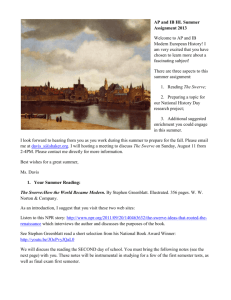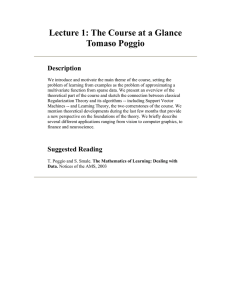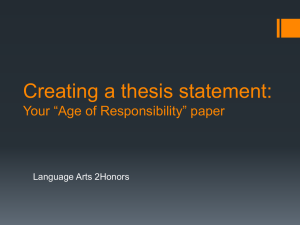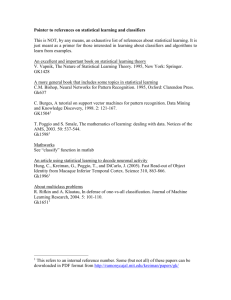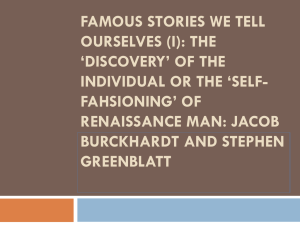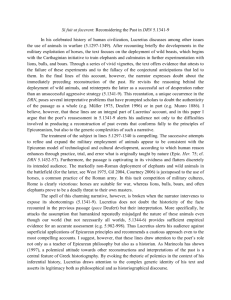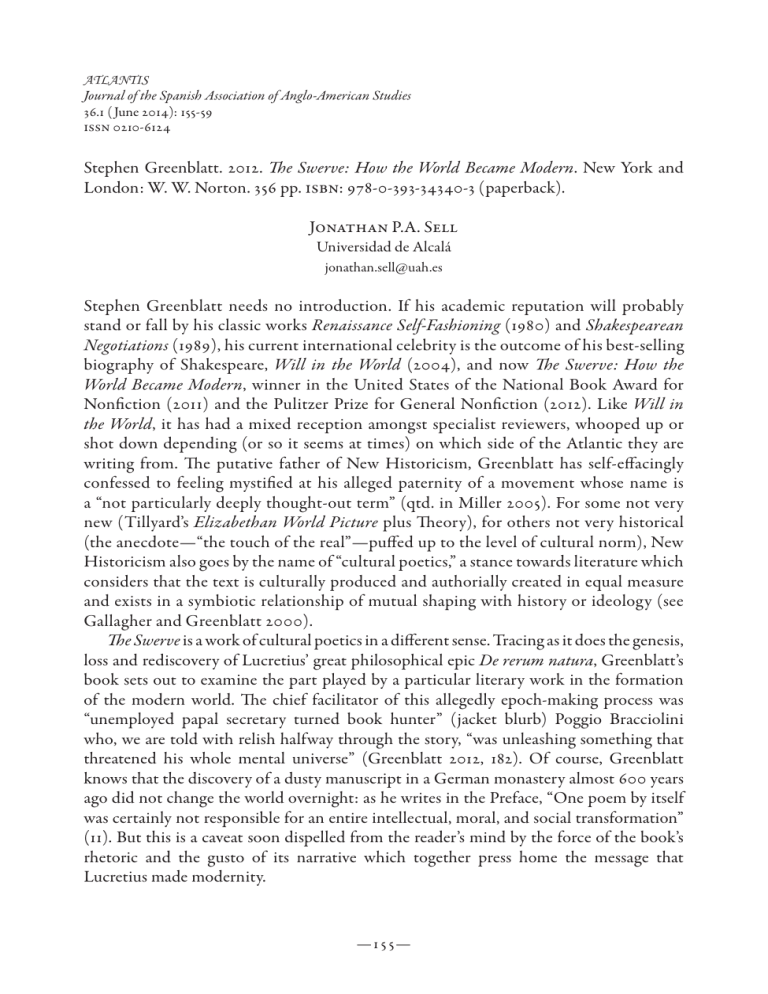
ATLANTIS Journal of the Spanish Association of Anglo-American Studies 36.1 ( June 2014): 155-59 issn 0210-6124 reviews Stephen Greenblatt. 2012. The Swerve: How the World Became Modern. New York and London: W. W. Norton. 356 pp. isbn: 978-0-393-34340-3 (paperback). Jonathan P.A. Sell Universidad de Alcalá jonathan.sell@uah.es Stephen Greenblatt needs no introduction. If his academic reputation will probably stand or fall by his classic works Renaissance Self-Fashioning (1980) and Shakespearean Negotiations (1989), his current international celebrity is the outcome of his best-selling biography of Shakespeare, Will in the World (2004), and now The Swerve: How the World Became Modern, winner in the United States of the National Book Award for Nonfiction (2011) and the Pulitzer Prize for General Nonfiction (2012). Like Will in the World, it has had a mixed reception amongst specialist reviewers, whooped up or shot down depending (or so it seems at times) on which side of the Atlantic they are writing from. The putative father of New Historicism, Greenblatt has self-effacingly confessed to feeling mystified at his alleged paternity of a movement whose name is a “not particularly deeply thought-out term” (qtd. in Miller 2005). For some not very new (Tillyard’s Elizabethan World Picture plus Theory), for others not very historical (the anecdote—“the touch of the real”—puffed up to the level of cultural norm), New Historicism also goes by the name of “cultural poetics,” a stance towards literature which considers that the text is culturally produced and authorially created in equal measure and exists in a symbiotic relationship of mutual shaping with history or ideology (see Gallagher and Greenblatt 2000). The Swerve is a work of cultural poetics in a different sense. Tracing as it does the genesis, loss and rediscovery of Lucretius’ great philosophical epic De rerum natura, Greenblatt’s book sets out to examine the part played by a particular literary work in the formation of the modern world. The chief facilitator of this allegedly epoch-making process was “unemployed papal secretary turned book hunter” (jacket blurb) Poggio Bracciolini who, we are told with relish halfway through the story, “was unleashing something that threatened his whole mental universe” (Greenblatt 2012, 182). Of course, Greenblatt knows that the discovery of a dusty manuscript in a German monastery almost 600 years ago did not change the world overnight: as he writes in the Preface, “One poem by itself was certainly not responsible for an entire intellectual, moral, and social transformation” (11). But this is a caveat soon dispelled from the reader’s mind by the force of the book’s rhetoric and the gusto of its narrative which together press home the message that Lucretius made modernity. —155— 156 jonathan p.a. sell Chapter one introduces us to Poggio riding horseback through Southern Germany in the winter of 1417. And that is all that happens, or all we can surmise actually happened. Which is why, less than four lines into his tale, Greenblatt switches to subjunctive mode: “As must have been immediately apparent . . . he would probably have been . . . would have” (14). Here and throughout the book, the paucity of the historical record is made good by speculation, or by the sort of negative historiography Nicholas of Cusa might have indulged in: That [Poggio] was not country-bred was clear, and yet he did not resemble any of the city and court dwellers . . . . Unarmed and unprotected by a clanging suit of armor, he was certainly not a Teutonic knight—one stout blow from a raw-boned yokel’s club would have easily felled him. Though he did not seem to be poor, he had none of the familiar signs of wealth and status: he was not a courtier, with gorgeous clothes and perfumed hair worn in long lovelocks, nor was he a nobleman out hunting and hawking. And, as was plain from his clothes and the cut of his hair, he was not a priest or a monk. (14) Padding of this sort is rife in a work whose threadbare plot becomes an excuse for a series of lengthy excursions into various chapters of European cultural history from Ptolomaic Alexandria to Renaissance Florence, while Lucretius’ poem and book-hunting Poggio can only stand by and watch from the sidelines. Unfortunately that history is an all too familiar landscape of cliché and stereotype: the Roman senatorial class spent every available moment of leisure reclining, nibbling grapes and discussing philosophy; the byways of early fifteenth-century Germany were traipsed by bands of “masterless men;” Renaissance courtiers, curial officials and popes were all irremediably venal and scurrilous. When not hawking second-hand wares, by enshrining the scabrous and anecdotal— lowlights include the mortification practised by Henry Suso and Elsbeth of Oye, the imprisonment of Jan Hus and the bridling of Giordano Bruno (108, 168, 240-41)— Greenblatt’s account of the past risks becoming the Horrible History Terry Deary and his imitators have so successfully served up to recent generations of British schoolchildren. Most alarmingly, the reduction of history to cliché leads to the glib formulation of untenable generalizations. Speaking, for instance, of the rise of monastic asceticism between the fourth and eleventh centuries CE and its pernicious spread through medieval Europe, Greenblatt writes, “In one of the great cultural transformations in the history of the West, the pursuit of pain triumphed over the pursuit of pleasure” (103). One wonders if the forebears of the footsore “masterless men” noticed any difference, and Poggio’s own eyewitness account of fun-loving Baden (173-76) rather spoils Greenblatt’s case; but the damage has been done and one is left either to pay obeisance at the feet of the Harvard philosophe or to lament the dumbing-down apparently required by addressing a nonspecialist public. But to return to the story: in chapter one, Poggio rides through southern Germany en route, most probably, to the monastery of Fulda; Greenblatt offers an excursus on ATLANTIS. Journal of the Spanish Association of Anglo-American Studies. 36.1 ( June 2014): 155-59· issn 0210-6124 reviews 157 those “masterless men” and a brief summary of Poggio’s biography to date. In chapter two, Poggio discovers the manuscript of Lucretius; excursus on monks as “principal readers, librarians, book preservers and book producers of the western world” (29) and on scribes and scriptoria. In chapter three, Poggio is abandoned in favour of a sketch of the lives and philosophy of Epicurus and Lucretius, the reception they may have enjoyed among Roman readers and an excursus on archaeological finds at Herculaneum, notably at the House of the Papyri, which, back in subjunctive mood, may have belonged to Epicurean Philodemus who may have possessed a codex of De rerum natura. Chapter four narrates the “Great Vanishing” (86) of the ancient world’s written cultural capital due to the ravages of time, Christian philistinism and, above all, the destruction of the library of Alexandria; it is in this chapter that Greenblatt introduces the pain principle and institutionalised selfflagellation as a pious response to Epicurean pleasure. By providing a useful potted history of the Florentine renaissance, chapter five returns us to Poggio and the main plot; despite gestures at continuist views of the renaissance, Greenblatt’s account is the traditional one, Petrarch the leading light. In chapter six Poggio attains the position of apostolic secretary to “the sinister, sly and ruthless Baldassare Cossa” (154), and we learn of his spats with Lorenzo Valla and of the Aretine smut that besmirched the Curia in Rome. In chapter seven Poggio is at the Council at Constance where the claims are to be settled of the three self-appointed popes, Cossa, Pedro de Luna and Angelo Correr; this permits Greenblatt to weave Hus into his tale and leaves Poggio only a horse-ride away from Fulda. Chapter eight is a digest of the philosophical ideas of De rerum natura, “almost every one of [whose] key principles was an abomination to right-thinking Christian orthodoxy” (202). Well, yes and no: as Greenblatt himself acknowledges earlier, “early Christians, Tertullian among them, found certain features in Epicureanism admirable,” particularly its ethics (101) which, as Greenblatt demonstrates later, the fatefully orthodox Thomas More would implant in his Utopia (227-33); and the mantra of the ancient materialist philosophers, “ex nihilo nihil fit” was conveniently paralleled in Solomon’s “there is nothing new under the sun” (Ecclesiastes 1.9-10), as Giordano Bruno among others would point out. Chapter nine completes Poggio’s biography: almost four years in the service of Henry Beaumont (bishop of Winchester and uncle of Henry V), late second marriage, Chancellor of Florence. The last two chapters, ten and eleven, bring us to the material which should prove Greenblatt’s thesis that, indeed, Lucretius’ De rerum natura created the modern world. The influence of Lucretius is traced in Macchiavelli’s view of religion as a means of repression through fear; in Valla’s On Pleasure (De voluptate), written in the 1430s, not published until much later; in More’s Utopia; in the works of Bruno; and, almost in passing, in the atomism of Thomas Hariot. Shakespeare is given short shrift (Mercutio’s “atomi,” Romeo and Juliet I.iv.58), Spenser and Donne none at all, though their Lucretianism is beyond doubt (Greenlaw 1920; Hirsch 1991; Passannante 2008); Montaigne is given pride of place; then a quick sprint through Pierre Gassendi, who reconciled atomism with Christianity in the 1640s, Lucy Hutchinson, Isaac Newton and Erasmus Darwin ATLANTIS. Journal of the Spanish Association of Anglo-American Studies. 36.1 ( June 2014): 155-59· issn 0210-6124 158 jonathan p.a. sell leads us to Thomas Jefferson’s 1820 confession that “I am an Epicurean” (263). Greenblatt is silent on Erasmus’ Epicureus (1533) and on the important Spanish transmission of Epicurean ideas, through Juan Luis Vives among others, which found an outlet in La vida de Lazarillo de Tormes (1554?) (Colahan 2001). Above all, he ignores Francesco Zabarella’s defence of Epicureanism (De felicitate, 1400), mentioned in the standard history of Italian philosophy (Garin 2008, 189), and thirteenth-century debates over the relative merits of Epicureanism, Stoicism and Scepticism, in which a leading figure was Siger of Brabant (c.1240-1280). The problem Zabarella and Siger pose for Greenblatt’s thesis is, of course, that they had detailed knowledge of Epicureanism before Poggio’s discovery of the manuscript at Fulda, which rather blows a hole in his thesis. So too did Isidore of Seville, Bede, Hrabanus Maurus, William of Conches and Vincent of Beauvais (Stones 1928; Bercovitch 1968). In fact, after Plotinus medieval philosophers devoted great energy to the vexed issue of whether the ancient materialists were merely “naturalist philosophers” or could be Platonised and made compatible with Christian doctrine. In short, despite Vesuvius and the destruction of the library of Alexandria, ancient materialist ideas and Epicureanism had survived and modernity might well have been possible without the kick-start provided by Poggio’s discovery. Except for Gillespie and Hardie (2007), Osler (2007) and Struever (1992), little has been published on the true and intricate history of the transmission of Epicureanism or “atomism” before Gassendi. Any approach to this tradition would need to take full stock of the references to Epicurus (and Empedocles, Leucippus and Democritus) not only in Diogenes Laertius, but also in Aristotle, Plato and Cicero, and to Epicurus and Lucretius in Seneca, Pliny the Elder and Plutarch’s Moralia; it would need to be familiar with the Neoplatonists and the medieval transmission of Epicurean ideas; it would need to explore the many different ways in which ideas were exchanged between Italy and England in the fifteenth and sixteenth centuries. Greenblatt’s book does none of this. Most disappointingly, in a work inspired by the writer’s avowed love of Lucretius, precious little of the poetry actually gets in, apart from raunchier bits like the hymn to Venus and the celebration of human coupling. Lucretius is undoubtedly a poet for our non-foundational times, his a voice wiser, more humane and less shrill than the stridencies of Christopher Hitchens and Richard Dawkins. He deserves better representation than that afforded by Greenblatt’s book. Works cited Bercovitch, Sacvan. 1968. “Empedocles in the English Renaissance.” Studies in Philology 65 (1): 67-80. Colahan, Clark. 2001. “Epicurean vs. Stoic Debate and Lazarillo’s Character.” Neophilologus 85 (4): 555-64. Gallagher, Catherine and Stephen Greenblatt. 2000. Practicising New Historicism. Chicago: u of Chicago p. ATLANTIS. Journal of the Spanish Association of Anglo-American Studies. 36.1 ( June 2014): 155-59· issn 0210-6124 reviews 159 Garin, Eugenio. 2008. History of Italian Philosophy, translated by Giorgio Pinton. 2 vols. Volume 1. Amsterdam and New York: Rodopi. Gillespie, Stuart and Philip Hardie, eds. 2007. The Cambridge Companion to Lucretius. Cambridge: Cambridge UP. Greenblatt, Stephen. 1980. Renaissance Self-fashioning. Chicago: u of Chicago p. —. 1989. Shakespearean Negotiations: The Circulation of Social Energy in Renaissance England. Oxford: Clarendon. —. 2004. Will in the World: How Shakespeare Became Shakespeare. London: Cape. Greenlaw, Edwin. 1920. “Spenser and Lucretius.” Studies in Philology 17 (4): 439-64. Hirsch, Hedrich D. A. 1991. “Donne’s Atomies and Anatomies: Deconstructed Bodies and the Resurrection of Atomic Theory.” Studies in English Literature 31 (1): 69-94. Miller, Lucasta. 2005. “The Human Factor.” http://www.guardian.co.uk/books/2005/ feb/26/biography. Osler, Margaret J., ed. 2007. Atoms, Pneuma and Tranquility: Epicurean and Stoic Themes in European Thought. Cambridge: Cambridge UP. Passannante, Gerard. 2008. “The Art of Reading Earthquakes: On Harvey’s Wit, Ramus’s Method, and the Renaissance of Lucretius.” Renaissance Quarterly 61 (3): 792-832. Stones, G. B. 1928. “The Atomic View of Matter in the xvth, xvith and xviith Centuries.” Isis 10 (2): 445-65. Struever, Nancy S. 1992. Theory as Practice: Ethical Inquiry in the Renaissance. Chicago: u of Chicago p. Received 25 March 2013 Accepted 13 September 2013 Jonathan P.A. Sell lectures at the University of Alcalá. Recent publications include Rhetoric and Wonder in English Travel Writing, 1560-1613 (2006), Allusion, Identity and Community in Recent British Writing (2010), Conocer a Shakespeare (2012) and, as editor, Metaphor and Diaspora in Contemporary Writing (2012). He is currently researching early modern libertinism and ideas of the sublime. Address: Escuela Universitaria de Magisterio. C/Madrid, 1. 19001, Guadalajara, Spain. Tel.: +34 949 209806. ATLANTIS. Journal of the Spanish Association of Anglo-American Studies. 36.1 ( June 2014): 155-59· issn 0210-6124
